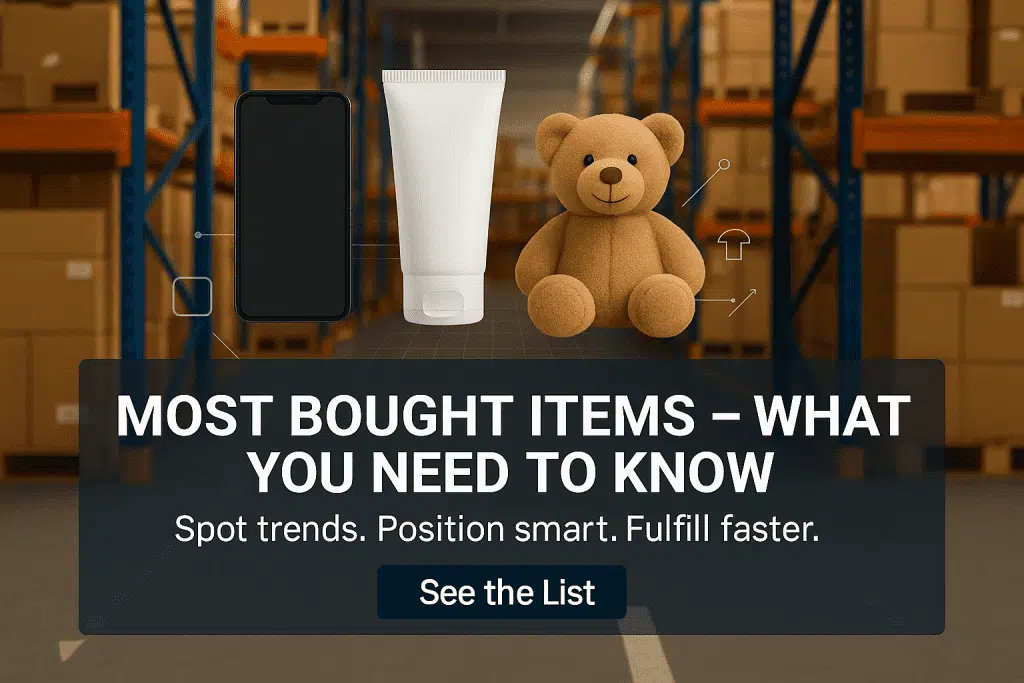Author: Jason Martin
Reviewed by: Ecommerce Operations Lead
Last updated: September 20, 2025
Executive TLDR
2025 Amazon demand is heavy in Home and Kitchen, Beauty and Personal Care, Health and Household, Electronics and Phone Accessories, Pet Supplies, and Toys and Games.
These categories skew small, light, and non-fragile, which is perfect for a central Midwest hub with 1 to 3 day ground reach.
You win on speed and accuracy with clean product data, barcodes that scan, right size packaging, and FEFO for dated goods.
Rate shop every label, use a simple box or mailer matrix, and keep single inventory pooled for DTC, Amazon, and retail.
Pilot first, then scale with standard work, weekly reviews, and live metrics.
Want a 2025-ready Amazon fulfillment plan — Contact Product Fulfillment Solutions
Table of contents
What changed on Amazon since 2021
The 7 Amazon categories driving 2025 volume
What that means for packaging and carriers
The playbook to hit speed without killing margin
Why Product Fulfillment Solutions
FAQ
The 7 Amazon categories driving 2025 volume
1) Home and Kitchen
Blenders, organizers, small storage, countertop helpers. These items are light, repeatable, and sensitive to DIM weight. Use a mailer or small box matrix and place top movers near pack. Explore pick and pack services.
2) Beauty and Personal Care
SPF, serums, masks, grooming tools. Treat as dated when applicable. Capture lot and expiry at receiving and enforce FEFO at pick. See health and wellness fulfillment services.
3) Health and Household
Vitamins, supplements, first aid, home tests. These require FEFO, clear storage, and scan at pack. Consider kitting assembly services for bundles and subscriptions.
4) Electronics and Phone Accessories
Cables, chargers, cases, earbuds. Tiny, high-velocity, look-alike SKUs. Separate bins, large labels, and a second scan at pack prevent swaps. Use 3PL fulfillment to standardize.
5) Pet Supplies
Treats, grooming, toys, small care items. Keep flavors and sizes apart with clear bin IDs. Right size packaging to avoid damage and DIM surprises. Protect margin with discounted shipping rates.
6) Toys and Games
Cards, collectibles, small sets. Batch single-line orders for speed, then cluster pick multi-line. Scan at pack and add corner protection where needed.
7) Grocery and Snacks, Lightweight
Pouches, bars, instant mixes. Date control and moisture protection matter. Keep airflow in storage and rotate with FEFO.
Across all seven, a central Cincinnati hub covers most buyers in 1 to 3 day ground, which supports Prime-level expectations without living on air.
What that means for packaging and carriers
Cartonization matrix: A short, posted matrix by product family prevents oversized boxes. Mailers for protected items, small cartons for fragile or multi-piece.
Insert rules: Use simple care or how-to inserts. Skip heavy marketing that complicates blind shipping.
Label timing: Print labels after the last scan at pack to cut waste and mislabels.
Carrier mix: Nationals plus regional carriers for dense lanes. Rate shop by weight, zone, and promise date. Tie the engine to ecommerce fulfillment services.
The playbook to hit speed without killing margin
Step 1, clean the data
One barcode per sellable unit. Accurate dimensions and weights. Clear hazard flags. Post unit, inner, carton label placements. Keep the master inside real-time information so teams trust the numbers.
Step 2, receive with discipline
Book dock times. Match carton contents to ASN fields. Hit 1 to 3 day dock to stock. For overflow and staging, see warehousing and storage solutions.
Step 3, slot by velocity
Fast movers near pack. Separate look-alikes. Large, high-contrast bin IDs. Walk less, ship more.
Step 4, pack right every time
Simple matrix on the bench. Add a second scan for risky items. Keep a tiny exception lane for relabel or rebag so the main line never stalls.
Step 5, ship smart
Rate shop every label. Use ground for most orders, regional carriers for key lanes, and limited air for outliers. Monitor cost per order and on-time delivery daily.
Step 6, protect freshness and compliance
For supplements, cosmetics, and snacks, capture lot and expiry at receiving and pick FEFO. Audit a few bins daily.
Step 7, pilot then scale
Start with the top 20 percent SKUs for one to two weeks. Fix slotting and packaging issues. Roll learnings to the next tier and add retail overlays with EDI solutions and connections.
Why Product Fulfillment Solutions
Central U.S. hub in Cincinnati with 1 to 3 day ground coverage to most customers.
Barcode-first receiving aligned to your ASN for consistent dock to stock speed.
FEFO and lot or expiry control for supplements, vitamins, and cosmetics.
Pick and pack standards with right size packaging and scan at pack.
Small parcel optimization that rate shops every label.
Multichannel ready for Amazon, DTC, TikTok Shop, and retail from one inventory pool.
FAQ
Which categories should small brands start with on Amazon
Start where items are light and repeatable. Home and Kitchen, Beauty, Health and Household, and Phone Accessories are common fits.
How do I avoid split inventory
Keep one central pool. Add nodes only when data proves savings. A Midwest hub covers most buyers fast on with ground shipping.
What accuracy should we target
Aim for 99.7 percent or better. Use a second scan at pack and separate look-alike SKUs.
Do I need FEFO for non-ingestibles
Use FEFO for dated goods. For the rest, focus on barcode accuracy and clean locations.
How soon can we pilot
Within two weeks once data and labels are locked. Start small, measure, and then scale in waves.

